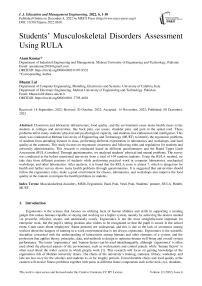Students’ Musculoskeletal Disorders Assessment Using RULA
Автор: Atam Kumar, Bharat Lal
Журнал: International Journal of Education and Management Engineering @ijeme
Статья в выпуске: 6 vol.12, 2022 года.
Бесплатный доступ
Classroom and laboratory infrastructure, food quality, and the environment cause many health issues to the students at colleges and universities, like back pain, eye issues, shoulder pain, and pain in the spinal cord. These problems affect many students' physical and psychological capacity, and students lose enthusiasm and intelligence. This study was conducted at Mehran University of Engineering and Technology (MUET) to identify the ergonomic problems of students from attending lectures in class, performing different experiments in laboratories and workshops, and food quality at the canteens. This study focuses on ergonomic awareness and following rules and regulations for students and university administration. This research is conducted based on different questionnaires and the Rapid Upper Limb Assessment (RULA) method. Through questionnaires, we analyzed students’ physical and mental problems. The survey was conducted at the before mentioned university from a total of 104 random students. Using the RULA method, we take data from different postures of students while performing practical work in computer laboratories, mechanical workshops, and other laboratories. After analysis, it is found that the RULA score is almost 7, which is dangerous for health and further survey shows many health problems through questionnaires. It is suggested that universities should follow the ergonomics rules, make a good environment for classes, laboratories, and workshops also improve the food quality at the canteen to mitigate the health problems in students.
Musculoskeletal disorders, MSDs Ergonomic, Back Pain, Neck Pain, Students’ posture, RULA, Health, MUET
Короткий адрес: https://sciup.org/15018576
IDR: 15018576 | DOI: 10.5815/ijeme.2022.06.01
Текст научной статьи Students’ Musculoskeletal Disorders Assessment Using RULA
Ergonomics is the science that focuses on utilizing facts of human abilities and skills in supporting a running gadget that makes humans capable of staying and working on a higher system, namely by achieving the desires needed via powerful, efficient, secure, and additionally comfy. Ergonomics is not the most straightforward important for enterprise work, but the pupil’s sitting position also wishes to be recognized so that the pupil is secure in the school room. Court cases about employees’ frame postures are widespread, and this is due to the lack of awareness among workers about the dangers of running in a work environment that is not always ergonomic. Ergonomics is the scientific discipline concerned with the understanding of interactions among humans and other elements of a system, and the profession that applies theory, principles, data, and methods to design to optimize human well-being and overall system performance. The terms ‘ergonomics’ and ‘human factors can be used interchangeably, although ‘ergonomics’ is often used about the physical aspects of the environment, such as workstations and control panels, while ‘human factors’ is often used about the wider system in which people work [1]. This research will focus on gaining knowledge of the ergonomics risk of Mehran university chairs. The chairs of the university’s training, canteens, library, workshop, and labs are less cozy for the scholars and students to sit for lengthy periods. Uncomfortable chairs and food quality at the canteen will motive fitness problems together with pains in different frame components such as the neck, eye, shoulder, spinal cord, knees, legs, and so forth. In the labs and classrooms, there is a need to change seating arrangements, lighting, place of a board, and multimedia because those are growing more fatigue and infected also causing many health issues and humidity. At Mehran University, 70% of university students do not pay attention to ergonomics guidelines and policies, there is no proper guidance or awareness study conducted to deal with such issues. Therefore, this study highlights the ergonomics problem at MUET and provides awareness to the students, teachers, and administration staff.
2. Literature Review
Musculoskeletal disorders (MSDS) are problems that purpose signs of ache in diverse frame locations consisting of the neck, shoulders, wrists, hips, knees, and heels [2]. Low back ache (LBP) is a prime fitness hassle, and LBP afflicts a third of the grownup populace at some time in their lives; approximately 12% to 44% of human beings have LBP at any given time and an estimated factor prevalence of 33% amongst workplace workers [3]. Workplace for employees depends on various behavioral patterns while operating in a static sitting role for more time using a small range of muscle groups of their hands, wrists, and arms; and are vulnerable to poor body posture. Such operating situations generate musculoskeletal issues, which can result in uneasiness or aches, which has an awful effect on existence. “LBP among office workers” is an attractive topic among researchers because of its high occurrence in this particular group. In [4] a survey performed among Dutch running organizations and office employees, musculoskeletal problems, particularly LBP, were related to lengthy-duration illness absence. At the same time as the ever-increasing utilization of computers within the administrative center has improved the velocity and accuracy of records processing, its effect on workers’ fitness because of over-usage cannot be omitted. Essential fitness issues like WMSD and RSI must grow to be not unusual phenomena. Given that, in universities today, most activities are completed with computer systems, the students, personnel, and professors are unaware of the risks of using computers over a significant duration each day. Work-related musculoskeletal disorders are a not unusual health challenge and the primary source of occupational infection in the arena. Together with the associated fitness risks, the economic loss due to such disorders influences not only the individual but also the enterprise and society [5]. This looks at changes performed on the university to become aware of hazard factors and quantify postural strain. To research their working posture, this observation uses two physical evaluation strategies. The strategies are questioners and speedy higher Limb evaluation [6]. Musculoskeletal problems (MSDS) are increasing daily, especially in the neck and higher limbs. In the workplace, workers are one of the concerns of managers of organizations and occupational health and ergonomics engineers [7]. In addition, the superiority of MSDS in growing countries was reported to be between 15% and 70% relying on the form of computer paintings and the duration of touch with the computer notebook and Lower back pain (LBP) was the most stated of those disorders; paintings-related Musculoskeletal disorders (WMSDS) are a common fitness situation and a significant source of occupational infection during the arena. At present, MSDS are one of the maximum apparent troubles ergonomists encounter within the place of business all over the international. Medical situations identified as musculoskeletal or mental/intellectual (hereafter “mental”) problems are a prime cause of sick depart, threatening the welfare of individuals and the economics of organizations and society. Swedish facts show that the two diagnostic classes account for more than 60% of certified work-associated health lawsuits, with “I will leave longer than 90 days” [8].
Most ergonomic intervention studies are designed to look at the consequences of the reduction in applicable threat elements impacting the individual employee, while ignores the fitness outcomes of measures to enhance competitiveness and productiveness. The growing electricity of capital markets, globalization of monetary and product markets, thereby increasing the competition sector, and fast technological trade create pressures for high performance at both company and man or woman levels. Low lower back pain has been widely mentioned as being of considerable health and economic difficulty in industrialized nations [9]. Some authors have been blanketed in this review notion that a terrible sitting posture at faculty may additionally produce back and neck ache in the grownup running life, at the same time as others commented that the school classroom is also a workplace; its workers, i.e., its pupils are the grownup people of the day after today. Comparing the superiority of LBP between populations has become more challenging over the years because of sizeable methodological heterogeneity across studies and difficulties in acquiring genuine populace estimates. WHO (World Health Organization) states that these issues are because by several dangerous factors such as character elements, employment, and mental elements. The process elements in the query are awkward postures, static and repetitive movements, temperature, and vibrations. Psychological elements have monotonous work performance, little social interplay, and an absence of work manipulation. Besides the painting's postures of the employees, the posture of students sitting at the same time as attending the lecture can also have a significant impact on the future, and these studies will increase awareness of studying the ergonomics hazard of university chairs.
Musculoskeletal problems and pain are principal issues globally in Europe and Sweden, causing human suffering for the character and financial burdens for groups and societies. Amongst musculoskeletal issues, LBP and neck pain account for approximately 70% of incapacity [10]. One of the ordinary chances in industries is manual material along with the U.S. branch of hard work; managing is defined as Seizing, protecting, grasping, turning, or otherwise working with the hand or palms. Arms are worried simplest to the volume that they are an extension of the hand, along with turning a switch or shifting vehicle gears [11]. In today's ever-evolving enterprise environment and unpredictability of human elements, hazard evaluation in an enterprise might be essential to securing the enterprise's economic future by ensuring the protection of its paintings pressure and getting rid of damaging operating conditions. There are threat elements associated with an everyday place of work, especially for people who have to do with manual fabric handling in a conventional warehouse putting [12] fabric coping with is an invariable a part of any production or provider operation, and there is continually a substantial human input to those operations in terms of physical load. The bodily load is the effect of force inputs for the duration of material dealing with operations from the interaction with cloth dealing with a system or the cloth [13]. The guide cloth dealing with is the chance undertaking which includes lifting and reducing the objects, pushing and pulling. Each manufacturing enterprise considers ergonomics the elaborate primary troubles that reason musculoskeletal disorders and the everyday health of personnel [14]. However, repetitive MMH activities, incorrect transfer position, and techniques in addition to heavy loads could chance the employees of an extreme case of decrease again ache (LBP) [15]. According to the study in [16] Musculoskeletal disorders of the upper limbs are one of the maximum frequent occupational issues among dental health care employees, and have psychological and social, in addition to physical outcomes. Research work in this area are the maximum important and the highest commonplace motives for misplaced workdays, expanded prices, and occupational issues in developed and growing countries [17]. Most of the ergonomics evaluation research so far had been carried out on industrial people; only a few studies have taken into consideration evaluating the operating postures of the team of workers, students or professors in universities who are uncovered to prolonged sitting.
3. Research Methods
After reading the literature, questioners were set for the survey form the students and data has been collected through questioners, therefore, this research is also based on questioners regarding ergonomics. Google form platform is used for the data collection. Further categorized into the four sections: Classrooms, Laboratories, Canteen, and Library. In every section, questions were asked according to the category. Total 104 random students take part in the survey.
-
a) RULA
Fig.1. Demonstrate a rapid assessment of individual worker exposure to ergonomic risk factors associated with upper extremity musculoskeletal disorders. The RULA Ergonomic Assessment Tool accounts for biomechanical and postural stress requirements for work tasks/neck, torso, and upper extremity requirements. Observe the position of each body segment, the greater the deviation from the neutral posture, the higher the score for each body part. Risk is calculated on a score from 1 (low) to 7 (high). The classification of this posture and strength and the impact level to evaluate. From this figure, the RULA score is considered at different angles depending on the given posture: neck
4. Result and Discussion
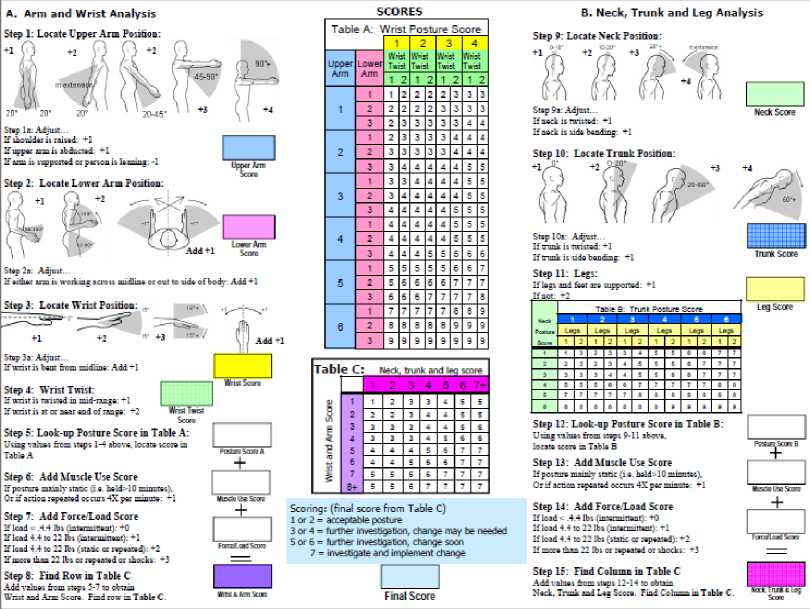
Fig. 1. RULA score analyzing table [18]
position, torso position, arm position, and wrist position. Finally, we add up all posture scores and analyze if there are any problems.
RULA is the method that is used in ergonomics for analyzing different working postures. We analyze employees' work using RULA; firstly, provides a method of screening a working population to assess exposure to a significant risk of work-related upper extremity disorders. Secondly to identify the muscular effort associated with working postures and excessive forces while performing static or repetitive work, which may contribute to muscle fatigue. Thirdly to provide a simple scoring method with an action level output that identifies an indication of urgency. And moreover, provides a user-friendly assessment tool that requires minimal time, effort, and equipment.
Table 1. Procedure for calculating the RULA score
|
RULA Scoring |
|
|
Score |
Level of MSD Risk |
|
1-2 |
Negligible risk, no action required |
|
3-4 |
Low-risk change may be required |
|
5-6 |
Medium risk, further investigation, change soon |
|
6+ |
Very high risk, implement change now |
Chairs used in classrooms, Canteens at Mehran University are still not ergonomically best and are not adjustable height, the canteen's food is also not healthy, and other workshops require personal protective equipment (PPE) and are stiff. Chairs are often lamented by students, who also complain about the food. This study responded by the number of students who randomly did activities. Two methods of data analysis have been used here: RULA and Survey.
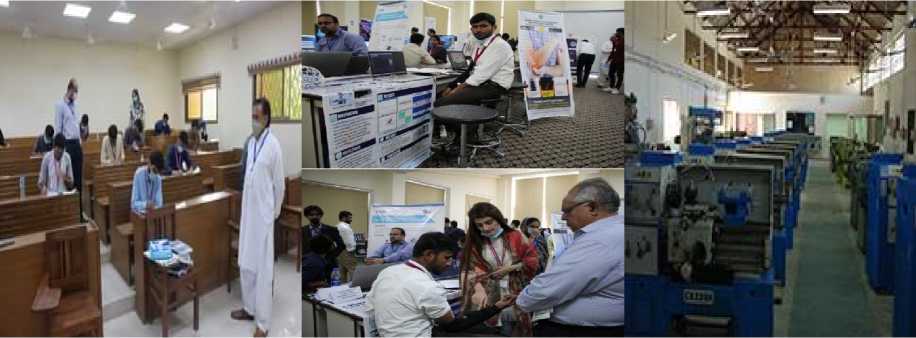
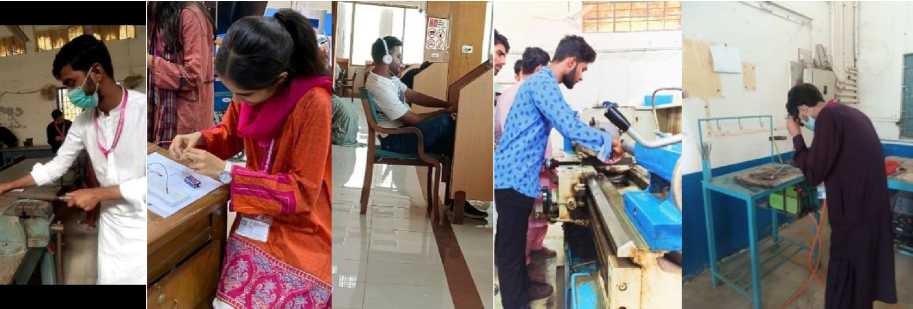
Fig. 2. Students performing different practical work in lab
5. RULA Method
The following RULA tables give different scores of various numbers of students by which it can be analyzed whether he/she working in good postures or not.
Table 2. RULA assessment of wrist Posture score
|
Wrist Posture Score |
|||||||||||
|
1 |
2 |
3 |
4 |
||||||||
|
Twist wrist |
|||||||||||
|
Upper Arm |
Lower arm |
1 |
2 |
1 |
2 |
1 |
2 |
1 |
2 |
||
|
1 |
1 |
1 |
2 |
2 |
2 |
3 |
3 |
3 |
|||
|
2 |
2 |
2 |
2 |
3 |
3 |
3 |
3 |
||||
|
3 |
2 |
3 |
3 |
3 |
3 |
4 |
4 |
||||
|
2 |
1 |
2 |
3 |
3 |
3 |
4 |
4 |
4 |
|||
|
2 |
3 |
3 |
3 |
3 |
4 |
4 |
4 |
||||
|
3 |
3 |
4 |
4 |
4 |
4 |
5 |
5 |
||||
|
3 |
1 |
3 |
3 |
L |
4 |
4 |
4 |
5 |
5 |
||
|
2 |
4 |
4 |
4 |
4 |
4 |
4 |
5 |
5 |
|||
|
3 |
4 |
4 |
4 |
4 |
4 |
5 |
5 |
5 |
|||
|
4 |
1 |
4 |
4 |
4 |
4 |
4 |
5 |
5 |
5 |
||
|
2 |
4 |
4 |
4 |
4 |
4 |
5 |
5 |
5 |
|||
|
3 |
4 |
4 |
4 |
5 |
5 |
5 |
6 |
6 |
|||
|
5 |
1 |
5 |
5 |
5 |
5 |
5 |
6 |
6 |
7 |
||
|
2 |
5 |
6 |
6 |
6 |
6 |
7 |
7 |
7 |
|||
|
3 |
6 |
6 |
6 |
7 |
7 |
7 |
7 |
8 |
|||
|
6 |
1 |
7 |
7 |
7 |
7 |
7 |
8 |
8 |
9 |
||
|
2 |
8 |
8 |
8 |
8 |
8 |
9 |
9 |
9 |
|||
|
3 |
4 |
4 |
4 |
4 |
4 |
9 |
9 |
9 |
|||
|
Posture Score A |
Muscle Use Score |
Force/Load Score |
Wrist&Arm Score |
||||||||
|
4 |
+ 1 |
+ 0 |
= 5 |
||||||||
Table 3. RULA assessment of Trunk Posture Score
|
Trunk Posture Score |
||||||||||||||||
|
Neck Posture Score |
1 |
2 |
3 |
4 |
5 |
6 |
||||||||||
|
Legs |
Legs |
Legs |
Legs |
Legs |
Legs |
|||||||||||
|
1 |
2 |
1 |
2 |
1 |
2 |
1 |
2 |
1 |
2 |
1 |
2 |
|||||
|
1 |
1 |
3 |
2 |
3 |
3 |
4 |
5 |
6 |
6 |
7 |
7 |
|||||
|
2 |
2 |
3 |
2 |
3 |
4 |
5 |
5 |
6 |
7 |
7 |
7 |
|||||
|
3 |
3 |
3 |
3 |
4 |
4 |
5 |
6 |
6 |
7 |
7 |
7 |
|||||
|
4 |
5 |
5 |
5 |
6 |
6 |
7 |
7 |
7 |
7 |
7 |
8 |
8 |
||||
|
8 |
8 |
8 |
8 |
8 |
8 |
|||||||||||
|
6 |
8 |
8 |
8 |
8 |
8 |
8 |
8 |
9 |
9 |
9 |
9 |
9 |
||||
|
Posture Score B |
Muscle Use Score |
Force/Load Score |
Wrist&Arm Score |
|||||||||||||
|
8 + 1 + 0 = 9 |
||||||||||||||||
Table 4. RULA assessment of Neck, Trunk, and Leg Score
|
Neck, Trunk, Leg Score |
|||||||||
|
Wrist/Arm Score |
1 |
2 |
3 |
4 |
5 |
6 |
7+ |
||
|
1 |
1 |
2 |
3 |
3 |
4 |
5 |
r |
||
|
2 |
2 |
2 |
3 |
4 |
4 |
5 |
|||
|
3 |
3 |
3 |
3 |
4 |
4 |
5 |
|||
|
4 |
3 |
3 |
3 |
4 |
5 |
6 |
|||
|
(5] - |
|||||||||
|
56 |
4 |
4 |
5 |
6 |
6 |
7 |
|||
|
7 |
5 |
5 |
6 |
6 |
7 |
7 |
7 |
||
|
8 |
5 |
5 |
6 |
7 |
7 |
7 |
7 |
||
|
Wrist Arm score (Neck, Trunk, and leg score) = 5+ Medium risk, Need investigation and change soon |
|||||||||
After applying the RULA method, all respondents in the study scored 7 points, indicating that immediate postures should be corrected as they will lead to future health problems. This value is due to the student's sitting area, laboratory work, and workshop positions. Students who sit and work in various labs can trace back to nonadjustable height chairs, standing postures in labs, nonadjustable height in workshops, and working conditions. The chair's seat and back are not soft, and the curvature of the chair is not ergonomically suitable. From this method, all activities should be improved as soon as possible. Otherwise, it becomes dangerous for students.
6. Questioners
Randomly, we received 104 responses from Mehran university students. According to the collected responses, many students face many problems that can cause serious health problems. An online Google Form does this for surveys. These are divided into four sections: classrooms, canteen, libraries, and laboratories. In these sections, questions such about seating posture, seating arrangement, food quality, ergonomic perception, and a variety of other ergonomics-related questions. Some of these questions are listed below.
7. Questioners Responses 7.1 Students age
Most of the students are between 20 and 21 years, and about 30 percent are aged between 21 to 22 years. Approximately one-fifth of students are aged between 18 to 19 years. In contrast, only seven percent of students are above 23 years.
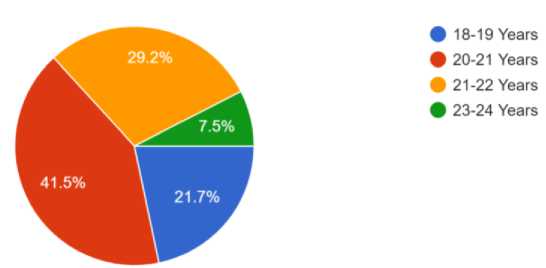
Fig. 3. Students' age chart
-
7.2 Approximate Height:
Figure 4 shows that most students are taller and between 5.5 to 6 feet. One-third of students' heights are above five and less than 5.5 feet, and only twelve percent of students' heights are between 4.4 to 5 feet. At the same time, no one is above six feet.
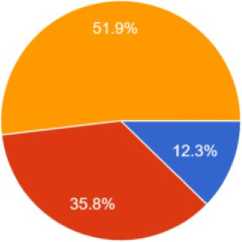
-
• 4.5 - 5 Feet
-
♦ 5 - 5.5 Feet Ф 5.5 - 6 Feet # Above 6 Feet
-
7.3 Part of the body becomes more fatigued when operating the machine.
Fig. 4. Students' height chart
About two third of the students are facing back bone pain while operating any machine during their laboratory practicals; the legs are the second most fatigued part of the body. Two to fifteen percent of the students face other problems like shoulders, knees, arms, and hands. At the same time, only one percent of the students face other problems such as hip, head, and other situation dependents.
Hands Legs Arms knees Shoulders Back bone
Nil
Hip
Ass/hip Head
It's depends on situation and w...
^^■—11 (10.4%)
^^^^^^■—21 (19.8%)
^^■—11 (10.4%)
2(1.9%)
^^^^■—15 (14.2%)
(0.9%)
(0.9%)
(0.9%)
(0.9%)
(0.9%)
О
1—76 (71.7%)
Fig. 5. Body part fatigue chart
-
7.4 Can the lab chairs be adjustable according to our height?
-
7.5 While I am looking at multimedia and feel pain.
Most students responded to this question as average, while the second highest response was uncertain. However, thirty percent of the students respond to this question as confident. As a result, some departments' infrastructure is excellent while others are not.
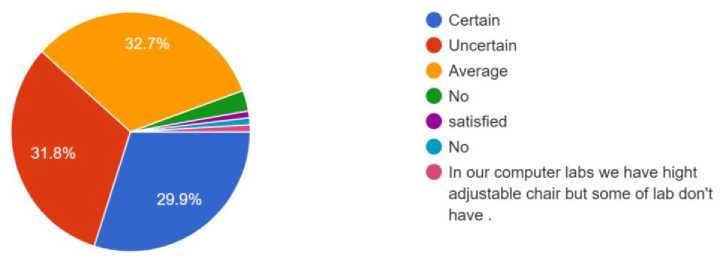
Fig. 6. Chair’s position and adjustment chart
Most students face neck pain while looking at the multimedia display during the lectures, eyes pain is the second most pain during the same, and the spinal cord comes the third. However, only one person responds to this question as no pain.
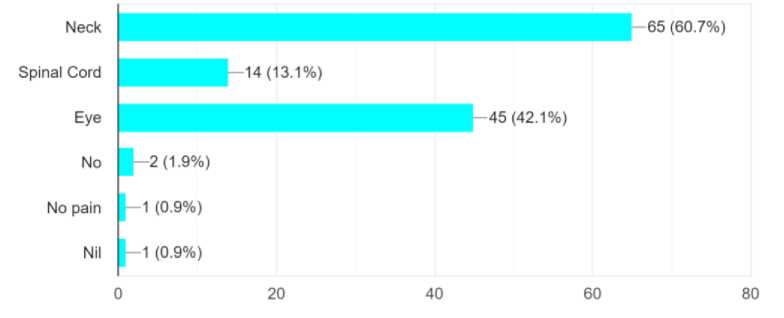
Fig. 7. Feeling pain while looking at the multimedia chart
-
7.6 Is the height of the classroom desk adjustable?
About half of the students responded to this question as the height of the classroom desks is adjustable, while forty percent responded as no, and eight percent contributed to other answers.

♦ Yes
♦ No
-
• May be
-
• yes
-
7.7 Food quality of our canteen?
-
7.8 Is there any ergonomic guidance given by teachers or any other person in the university?
Fig. 8. Classroom desk adjustable response chart
Different canteen services available at the university, about thirty-five percent of the students responded to this question as canteen food needs improvement at the same time a second significant part of the students satisfied from canteen food, and 22.6 percent responded as average. However, only 11.3 percent were satisfied with the food and responded as excellent.
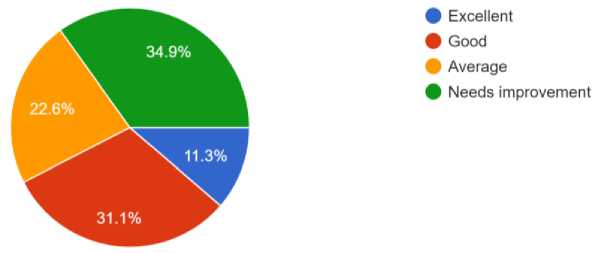
Fig. 9. Canteen food service response chart
Half of the students are facing ergonomic guidance from either teachers or other staff, about twenty-three percent are facing it somehow, and 30 percent are not facing this problem.
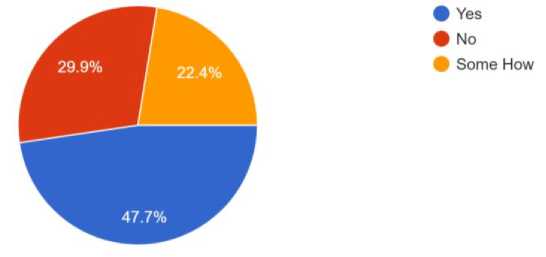
Fig. 10. Ergonomic guidance response chart
From the questions, it can be concluded that classroom and workshop chairs are not soft and adjustable to the height of students. From other questions, we observe that students have problems like back pain, neck pain, eyes, shoulders, etc. Food quality is not good; therefore, these all risks can cause health issues. As mentioned, RULA methods used for Upper limb assessment contain such as back pain, neck pain, or shoulders. Questioners are also giving us information about all these problems, and another thing is that questions also give us that food quality is not good and nobody is giving awareness, training, or knowledge about ergonomics. Therefore, University management should take serious action to improve all these things contributing to physical and psychological issues for students. Students do not know about human factors engineering, so university management and teacher should have given knowledge and training about ergonomics so they can keep quiet about health issues.
8. Conclusion
This study is providing basic knowledge of ergonomics, and awareness of ergonomics to the students, teachers, and staff. From the study, it can be concluded that Mehran University of Engineering and Technology is not providing awareness about ergonomics to the students and also not following proper rules and regulations of ergonomics, due to that students are facing back pain, knees, neck, and eyes problems, which can cause health issues in future. This study was taken from all over the Mehran University through 104 respondents using questioners and by applying RULA methods to get the score of students working in laboratories and workshops. According to the RULA assessment, the total score is 7, which indicates a hazardous situation. Therefore, university administration should take serious action and improve all systems to keep students safe from health issues.
9. Limitations and Future Recommendations
According to the study and results, the university administration should provide the proper awareness/training about ergonomics to the students, teachers, management, and canteen management. Every department should create a diverse and flexible environment that supports students and teachers’ diverse needs and abilities and also combine height-adjustable chairs with height-adjustable desks to allow students to optimize their working height while sitting and standing. Students need to work in the proper posture to reduce the chances of any fatigue or hazardless. The administration needs to arrange a good position for multimedia, machines, and board height where they stand up and move around in a good position. Also, canteen management should improve their food quality as students cannot be affected. This study is based on responses from random students at Mehran University of Engineering and Technology, and if the number of participants increases, it may cause different results. The main limitations of this study are that respondents are limited, further it can be accurately analyzed the problems by conducting survey from the students and faculty members as well.
Список литературы Students’ Musculoskeletal Disorders Assessment Using RULA
- I. Bolis, T. F. A. C. Sigahi, A. Thatcher, P. Saltorato, and S. N. Morioka, “Contribution of ergonomics and human factors to sustainable development: a systematic literature review,” Ergonomics, vol. 10, no. 114, pp. 1–19, Jun. 2022, doi: 10.1080/00140139.2022.2079729.
- Mulyadi, A. Nurwahidah, and D. Nismar Satria, “Ergonomic risk analysis of lecture chairs at the engineering faculty, Hasanuddin University,” IOP Conf. Ser. Mater. Sci. Eng., vol. 885, no. 1, 2020, doi: 10.1088/1757-899X/885/1/012033.
- S. A. Arslan et al., “Prevalence and Risk Factors of Low Back Pain Among the Office Workers of King Edward Medical University Lahore, Pakistan,” Phys. Treat. - Specif. Phys. Ther., vol. 6, no. 3, pp. 161–168, 2016, doi: 10.18869/nrip.ptj.6.3.161.
- C. A. M. Roelen, P. C. Koopmans, and J. W. Groothoff, “Subjective health complaints in relation to sickness absence,” Work, vol. 37, no. 1, pp. 15–21, 2010, doi: 10.3233/WOR-2010-1052.
- N. Chowdhury, “A Comparative Assessment of Ergonomic Risk Factors in University Personnel Using RULA and REBA Aiming to Study the Cause and Effect Relationship,” Louisiana State Univ. LSU Digit. Commons, pp. 1–93, 2015, doi: 08252015-170029.
- A. M. Hashim, S. Z. M. Dawal, and N. Yusoff, “Ergonomic evaluation of postural stress in school workshop,” Work, vol. 41, no. SUPPL.1, pp. 827–831, 2012, doi: 10.3233/WOR-2012-0249-827.
- M. S. Sohrabi and M. Babamiri, “Effectiveness of an ergonomics training program on musculoskeletal disorders, job stress, quality of work-life and productivity in office workers: a quasi-randomized control trial study,” Int. J. Occup. Saf. Ergon., vol. 0, no. 0, pp. 1–8, 2021, doi: 10.1080/10803548.2021.1918930.
- R. H. Westgaard and J. Winkel, “Occupational musculoskeletal and mental health: Significance of rationalization and opportunities to create sustainable production systems - A systematic review,” Appl. Ergon., vol. 42, no. 2, pp. 261–296, 2011, doi: 10.1016/j.apergo.2010.07.002.
- P. Grimes and S. Legg, “Musculoskeletal Disorders (MSD) in School Students as a Risk Factor for Adult MSD: A Review of the Multiple Factors Affecting Posture, Comfort and Health in Classroom Environments,” J. Human-Environment Syst., vol. 7, no. 1, pp. 1–9, 2004, doi: 10.1618/jhes.7.1.
- C. Lind, “Assessment and design of industrial manual handling to reduce physical ergonomics hazards – use and development of assessment tools,” in Doctoral Thesis, Technology and Health, KTH Royal Institute of Technology, no. August, 2017, p. 68. doi: 10.13140/RG.2.2.20231.91044.
- G. K. & A. O. Rakesh, S. C. Roy, “Review Case Study For Improving Manual Material Handling In Population Workplace,” Int. J. Ind. Eng. Technol., vol. 3, no. 4, pp. 73–78, 2013.
- J. S. Dzissah, “Author : Title : Peter , Amos Ergonomic Analysis of Manual Material Handling of Freights in a Trailer for Shipping Graduate Degree / Major : Research Advisor : Number of Pages : MS Degree in Risk Control Submission Term / Year : Spring 2019 Style Manual U,” pp. 1–60, 2019.
- R. Rajesh, “Manual Material Handling: A Classification Scheme,” Procedia Technol., vol. 24, no. 1978, pp. 568–575, 2016, doi: 10.1016/j.protcy.2016.05.114.
- M. Rajendran, A. Sajeev, R. Shanmugavel, and T. Rajpradeesh, “Ergonomic evaluation of workers during manual material handling,” Mater. Today Proc., vol. 46, pp. 7770–7776, 2021, doi: 10.1016/j.matpr.2021.02.283.
- B. M. Deros, D. D. I. Daruis, and I. M. Basir, “A Study on Ergonomic Awareness among Workers Performing Manual Material Handling Activities,” Procedia - Soc. Behav. Sci., vol. 195, pp. 1666–1673, Jul. 2015, doi: 10.1016/j.sbspro.2015.06.238.
- N. Chowdhury, F. Aghazadeh, and M. Amini, “Ergonomic assessment of working postures for the design of university computer workstations,” Occup. Ergon., vol. 13, no. S1, pp. 37–46, Feb. 2018, doi: 10.3233/OER-170252.
- R. Heidarimoghadam, I. Mohammadfam, M. Babamiri, A. R. Soltanian, H. Khotanlou, and M. S. Sohrabi, “Study protocol and baseline results for a quasi-randomized control trial: An investigation on the effects of ergonomic interventions on work-related musculoskeletal disorders, quality of work-life and productivity in knowledge-based companies,” Int. J. Ind. Ergon., vol. 80, no. April, p. 103030, Nov. 2020, doi: 10.1016/j.ergon.2020.103030.
- A. Dwyer, J. Huckleby, M. Kabbani, A. Delano, M. De Sutter, and D. Crawford, “Ergonomic assessment of robotic general surgeons: a pilot study,” J. Robot. Surg., vol. 14, no. 3, pp. 387–392, Jun. 2020, doi: 10.1007/s11701-019-00996-1.

